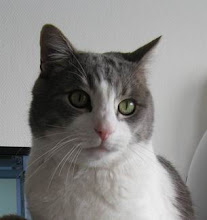Most of the time police forces should be respected and supported - they do a difficult job, and I'm sure most are trying to serve their communities.
But (and you knew one was coming) sometimes they make total arses of themselves. This time its the turn of the Aussie police. As reported worldwide, some comedians drove through the security around the APEC meeting using nothing more devilish than some Canadian flags (the Osama look-alike was merely a detail). The police just waved them through to the hotel where President Bush is staying.
So, what do the police do? They allowed these comedians through to the hotel, didn't stop them or apparently check their ID. They've charged them with "entering a secure area". Errrm, you let them. Does this mean that anyone who is allowed into a secure area should be arrested? Including Mr. Bush? Please?
Apparently the police are considering other charges. The comedians evidently have considerable skill at making people laugh at them and appearing absurd, so presumably they'll be charged with impersonating a police officer.
Read more!
Friday, 7 September 2007
The snipers were extra
Posted by
Bob O'Hara
at
16:34
3
comments
![]()
Thursday, 6 September 2007
Why I've not been blogging much
There's a monster guarding my laptop
I managed to drive it off for long enough to post this. But it'll be back.
Oh yes, it'll be back.
Read more!
Posted by
Bob O'Hara
at
20:43
0
comments
![]()
Monday, 3 September 2007
Wambam: the photos
Last week I was in Gotland for a meeting on the animal model (if you don't know, don't ask. It's safer that way). I took some photos, of varying quality.
All of the photos are on my Flickr page, but I thought this was worthy of more attention. It's Henrik demonstrating that mathematics really is gobbledigook, something we had merely suspected:
If anyone who was at the meeting would like to add links to their photos, or add anything else (e.g. transcriptions of Lars' poetry), please do!
Last but not least, the meeting was co-organised by Jon Brommer. He couldn't join us though, because he was waiting to become a father. He duly did that just before the meeting started, so congratulations to Jon and Marianne!
Read more!
Posted by
Bob O'Hara
at
19:53
3
comments
![]()
Labels: conference, Sweden, travel, WAMBAM
Sunday, 2 September 2007
ESEB Saturday
Phew, the last day.
We started with a plenary lecture by Scott Edwards. He was talking about phylogenetics, and making the point that gene trees are not the same as species trees. Err, OK, let's back up. A method used a lot to work out the relationship between species is to pick a gene (e.g. CO1), sequence it in different species, and use that to draw a tree. This works because when a species is split into two species, variation in the gene sequence can accumulate: mutations occur in one species, and can become fixed by random drift. The longer two species have diverged, the more differences in the sequences have accumulated.
One thing people in phylogenetics often want to estimate is when two species have diverged. They do this by drawing a phylogenetic tree from a gene sequence, and looking at time of the the relevant split in the tree. Edwards pointed out that this may not be the time when the species diverged. The problem is that just before two species diverge, there may be variation in the gene sequences in the population. The time of the gene's split would therefore be before the species' split, so the estimate of the split would be too old. The soluion to this is to use several genes in the building of the tree, and use a model that estimates the time of the species tree splits from the distribution of gene tree splits: the gene trees put an upper bound on the species tree splits (because the species have to split after the genes), and says more something about the distribution (if all gene split between 100 and 110 million years ago, the species trees split is unlikely to be 2 million years ago).
After the plenary, I wandered off to the session on evolution in agriculture. This has nothing to do with what I work on, so I was there out of curiousity. A couple of talks were about the origins agriculture in the middle east, and its spread through Europe. They used looked at gene sequences and inferred one or two originations, and Huw Jones showed that in barley they could find a signature of spread aong the Meditterranean to Spain, and a second spread through central an northern Europe. In contrast, Hazel Goodwin was unable to find any pattern of spread in wheat. The reason for the difference isn't clear.
After lunch, I went to the final session, on association mapping. This is an approach to mapping genes based on the correlation between genes or markers and a phenotype from individuals sampled from a population. It can go badly wrong because the association may not be because the markers are close to a gene affecting the trait, but instead because of population history: if the population being sampled is made up of two sub-populations, then there may be divergence in the trait, and also in genes nowhere near the any affectig the trait, just by chance. Association mapping would then pick up these relationships, and suggest they are causal.
After the talks were over, we adjourned to the castle for the banquet. The food was good, the wine was excellent, the speeches were short. And an evil Norwegian talked me into organising a session at the next ESEB meeting, in Turin in 2009.
Read more!
Posted by
Bob O'Hara
at
19:25
0
comments
![]()
Labels: conference, ESEB, evolution
